 image by Jarig Bakker, 1 September 2005
image by Jarig Bakker, 1 September 2005
Last modified: 2016-03-13 by rob raeside
Keywords: italy | houseflag | house flag |
Links: FOTW homepage |
search |
disclaimer and copyright |
write us |
mirrors
See also:
 image by Jarig Bakker, 1 September 2005
image by Jarig Bakker, 1 September 2005
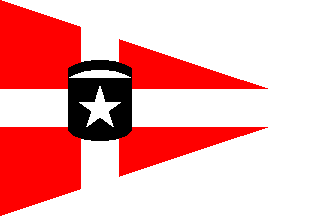 image by Jorge Candeias, 11 February 1999
image by Jorge Candeias, 11 February 1999
Variant ?
I believe that this is an italian company. The flag is a red
triangle with a white cross throughout and a black shield in the
center of the cross containing what seemed to be a 5-pointed
star. The original picture was too small, so I'm not at all sure
about the exact shape and charges of the shield (particularly the
shape above).
Jorge Candeias, 11 February 1999
The company is based in Genoa, so it is Italian company. The
image is based on <www.informare.it>.
Dov Gutterman, 11 February 1999
The company website shows an image of the houseflag being a
red pennant with a white cross surmounted by the black letter
logo "CM". The image displayed from the company website
has these letters replaced by a panel of the funnel i.e. black
with a white band above a white star. I can find nothing to
indicate that this is an actual flag or has replaced the other
and it appears to be merely a navigating button for their
website. The company have not responded to a query on this
matter.
Neale Rosanoski, 18 September 2002
Ignazio Messina & Cia., S.p.A., Genoa - red burgee, white
cross; in center intertwined "CM".
Source: Brown's Flags and Funnels Shipping Companies of
the World, compiled by J.L. Loughran, Glasgow, 1995.
Jarig Bakker, 1 September 2005
At the 1940 page at <www.24flotilla.com>:
"Ignazio Messina", Genoa - What we see is the variant
with initials, however the `C' encircles the `M'.
Jan Mertens, 8 January 2008
 image by António Martins-Tuválkin, 13 July 2008
image by António Martins-Tuválkin, 13 July 2008
Not much to be said on Ilva’s
house flag, fifth of second complete row in the 1940
Spanish source. It representing Soc[ietà] An[onima]
“Ilva” at Genova (i.e. Genoa): a pale blue swallowtail
with straight edges, completely bordered in white, a
white’$’ (dollar) sign in the centre.
What I take was the mother company, operating its own ships, is
presented at wikipedia.
Ilva (a family name but also ‘Elba’ in Latin) was the
name of a steel factory founded in 1905, at one point renamed
Italsider but now owned by the Riva Group.
Jan Mertens, 19 February 2008
I could add that the "$" dollar sign is of the
one-stroke sort and that the cut out seems to be orthogonal,
leaving the sign centered on the uncut area of the flag; the
fimbriation seems to be 1/10th of the flag height.
Researchers should broaden their prospective avenues to the
possiblity that this sign on this flag may have been influenced
not (only) by the U.S. or other dollars, but by the other
currencies that shared this sign at the time of the creation of
this flag.
António Martins-Tuválkin, 13 July 2008
 image by Jorge Candeias, 4 March 1999
image by Jorge Candeias, 4 March 1999
Unequal vertical tricolour of green white and red. The green
stripe bears the initials "RR" in white, the white
stripe (the narrower) bears something very similar to the
portuguese Coat of Arms ,a yellow circular device with holes
charged by a white shield with red border. The original picture
was too small to see clearly, but something seemed to be in the
shield. The red stripe (the wider) bears the initials
"ISI" in white.
Jorge Candeias, 4 March 1999
Rimorchiatori Riuiti International Shipping & Investments
Ltda formed in 1999 is the full name being a subsidiary of the
Rimorchiatori Riuiti S.p.A. group through Portunato & Co.
S.r.l..
Neale Rosanoski, 11 April 2003
 image by Jarig Bakker, 19 February 2005
image by Jarig Bakker, 19 February 2005
Soc. di Nav. a Vap. Istria, Trieste - blue flag, white
diamond, blue "S.I.T.".
Source: Brown's Flags and Funnels of British and Foreign
Steamship Companies, compiled by F.J.N. Wedge, Glasgow, 1926 [wed26]
Jarig Bakker, 19 February 2005
At the 1940 page at <www.24flotilla.com>:
"Istria", Trieste - Serifed initials; the diamond
touches the flag's edges. Company name (without `Vapore' which
may be a variant): `Società Anonima di Navigazione
Istria-Trieste' indicating where the flag's initials came
from. Different kind of blue probably is not
significant here.
Jan Mertens, 8 January 2008
 image by James Dignan , 13 December 1997
image by James Dignan , 13 December 1997
 image by Al Fisher , 1 February 1999
image by Al Fisher , 1 February 1999
"Italian Line" (probably wrong)
Houseflag of "Italia" Societa Anonima di
Navigazione.
James Dignan, 13 December 1997
"Italia di Navigazione Srl" is one of the partners
in MPE.
Dov Gutterman, 31 July 1999
Stewart shows spear as being white.
Al Fisher, 1 February 1999
Italia di Navigazione Srl and the Italian Line are one and the
same. Originating 1932 as Italia Flotte Riunite it was part of
the 1936 Italian Government reorganisation becoming from 1.1.1937
Società per Azione di Navigazione Italia and eventually ended
as Italia di Navigazione S.p.A. The flag combines those of
Genoa and Trieste with the latter emblem being a
"ranseur" or spear head. No other source suggests that
the spear was ever yellow.
Neale Rosanoski, 11 April 2003
Due to the 'thirties Depression, various Italian shipping
companies were united into a big concern. From The Ships
List, an overview <www.theshipslist.com>:
"In 1932, due to the depression and widespread unemployment
of Italian ships, the major Italian shipping companies were
combined into one state controlled syndicate under the name
Societa Italia Flotte Reuniti NGI - Lloyd Sabaudo - Cosulich. By
1937 this concern had made rapid recovery and repaid the
Government bonds which had supported it. It was then changed into
a Limited Company under the name Italia Societa Anonima di
Navigazione. Lloyd Triestino was incorporated into the new
company. A new holding company (FINMARE) was formed and created
four self contained shipping companies:
ADRIATICA based in Trieste to serve the Adriatic and comprised
Adriatica di Nav., Fiumana and Lloyd Triestino's local services.
TIRRENIA based in Naples served the Tyrrhenian Sea and comprised
Adria, Tirrenia and Sarda.
LLOYD TRIESTINO based Genoa which covered Africa and the Far
East. Comprised Lloyd Triestino, Libera Triestina, Italia Flotte
Reuniti's non North and South American routes plus Veneziana.
ITALIA to cover North and South America and comprised Italia
Flotte Reuniti, Cosulich, Libera Triestina and Veneziana.
In 1940 most Italian ships were taken over for military service
and by 1945, few were left afloat. The fleet was gradually
rebuilt but from 1960 the rising popularity of air travel
signalled the gradual decline of the passenger ships and they
were eventually switched to cruising. By 1977 all long distance
passenger travel had ceased, although many cargo ships continued
to carry a few passengers. A cruising company was set up (Italia
Crociere Internazionali) to employ the remaining passenger
vessels but ceased trading in 1980. Italia continued as a
freighting company, mostly with second hand or chartered
container ships and still operates, but in private
ownership."
Jan Mertens, 29 December 2003
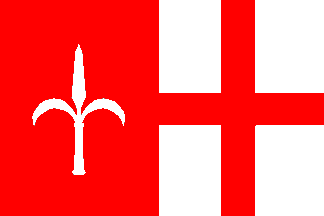 image by Jarig Bakker, 19 August 2004
image by Jarig Bakker, 19 August 2004
From the link provided by Barbara Tomlinson of The National
Maritime Museum <www.nmm.ac.uk>:
"The house flag of the Italia Societa Anonima di
Navigazione, Genoa. In this example the design appears to be
reversed. It combines the St George's Cross of Genoa with the
arms of Trieste, represented by a white halberd on a red field.
The flag is made of a wool and synthetic fibre bunting with a
linen hoist. It is machine sewn and the design is printed. A rope
is attached. The major Italian shipping lines were
nationalized under the holding company, Societa Finanziaria
Industriale Italiana in 1932 as a result of the depression. In
1936 the fleet was split into four divisions each serving an
agreed geographical area. Italia commenced operations the
following year on routes to North and South America. By the end
of the 1960s Italia's prestigious passenger liners were becoming
unprofitable owing to the competition from air transport and the
company switched its operations to freight. It is now in private
ownership as part of the Fratelli D'Amico Armatori Societa per
Azioni, Genoa."
It is possible that the Museum got it wrong, as it seems to be
the flag of Lloyd Triestino...
Jarig Bakker, 19 August 2004
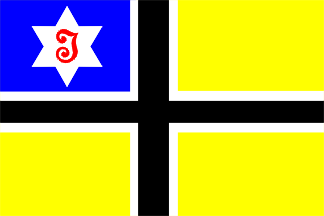 image by Jarig Bakker, 30 October 2006
image by Jarig Bakker, 30 October 2006
From <www.timetableimages.com>:
'Italia' Società di Navigazione a Vapore, Genoa. As it happens,
the on-line 1912 Lloyds Flags & Funnels has a nice clear
picture i.e. No. 1197 on (the electronic) p. 58 at <www.mysticseaport.org>:
yellow, a black cross throughout, a blue canton bearing a white
six-pointed star which in its turn bears what appears to be a red
mirrored figure '6'. Then, of course, it may well be a
handwritten uppercase 'I'. The card on <planeta.terra.com.br>,
however, shows a fimbriated cross.
More on this firm at planeta
site: founded in 1899 but under the control of the German
Hamburg-America Line which then (1906) moved to the Navigazione
Generale Italiana; becoming a de facto branch of this firm in
1917, sharing its fortunes from then on.
Jan Mertens, 14 July 2004
Italia Società di Navigazione à Vapore - Bonsor describes
the flag as having a blue cross so if it were a dark blue shade,
as also with the canton, it would fit in with the planeta site
image where the two do seem to be a similar colour and it would
explain the fimbriation of the cross. Bonsor calls the letter an
"I" which has to logical though it reminds me more of a
written "T", and makes no mention of the Lloyds
version.
Neale Rosanoski, 22 July 2004
There remains some doubt about the colour of the cross, and
whether it is fimbriated or not. See the picture at <www.civilization.ca>
showing the ship `Ancona' and some flags, the biggest of them representing
the company.
To my mind, the canton is blue, but the cross is black (and
fimbriated), the initial "I" is rather elaborate,
compare the capital letter to the right of the house flag. This
does not explain the choice of colours. (The six-pointed star
could be a variant of the five-pointed one which is one of
Italy's symbols, or even have a religious significance).
Jan Mertens, 30 October 2006
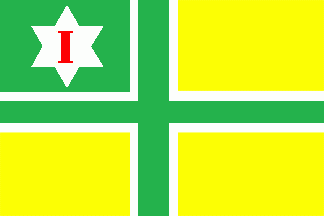 image by Klaus-Michael Schneider, 17 April 2009
image by Klaus-Michael Schneider, 17 April 2009
At least, I believe it is a flag variant of the flag of that
company, having a green fimbriated cross and a simple red,
serifed “I” upon the white star.
KLUDAS denotes the company as Italia Soc. Di Nav., located in
Genoa.
Source: Arnold KLUDAS: Die Geschichte der deutschen
Passagierschiffahrt (5 Bde.) Hamburg 1986; Reprint Laibach
Slovenia-Buch Nr. 03617-8 Flagchart p.223
Klaus-Michael Schneider, 17 April 2009
 image by Ivan Sache, 25 March 2001
image by Ivan Sache, 25 March 2001
The houseflag of the Italian shipping company 'Italian
Transporti Maritimi' is a white field with a St. George's cross
and a green star in canton. I suspect the company is (or was
originally) based in Genoa because of the St. George's cross.
Source: Znamierowski [zna00],
p. 245.
Ivan Sache, 25 March 2001
Full name is Compagnia Italiana Transporti Marittima S.A. and
it was based Genoa. Known as CITMAR it appears to have
ceased trading in the early 1970s.
Neale Rosanoski, 11 April 2003
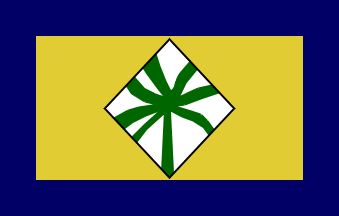 image by Eugene Ipavec, 27 January 2008
image by Eugene Ipavec, 27 January 2008
The top right house flag
of the 1940
Spanish source is the one representing the Italian company
Italo-Somala, based at Genoa: it is yellow with a wide dark blue
border (most instances of blue are rendered very dark in this
chart) and bears a white diamond in the centre, the upper and
lower edges of which touch the border; on the diamond is a green
palm tree.
The following text from <countrystudies.us>
describes pre- and post-WWII economic conditions in Italian
Somaliland, as it was once called, for instance the plantation
system introduced from 1920 on by the ‘Società Agricola
Italo-Somala’ (SAIS) i.e. Italo-Somali Agricultural Company:
Bananas, cotton, and sugarcane were grown but not all were
successful.
The list at <digilander.libero.it>
mentions a bibliography by Ernesto Milanese giving the dates
1921-1939 for the firm.
I have found no clear link with ‘Società Anonima di
Navigazione Italo-Somala’ (Genoa) which may have been the
shipping department of above firm or may have simply borne the
same name. Following text charts the career of the Duke of the
Abruzzi, a royal prince who was – among other things –
a famous mountain climber in his day and the driving force behind
SAIS: <www.vqronline.org>.
Jan Mertens, 22 January 2008